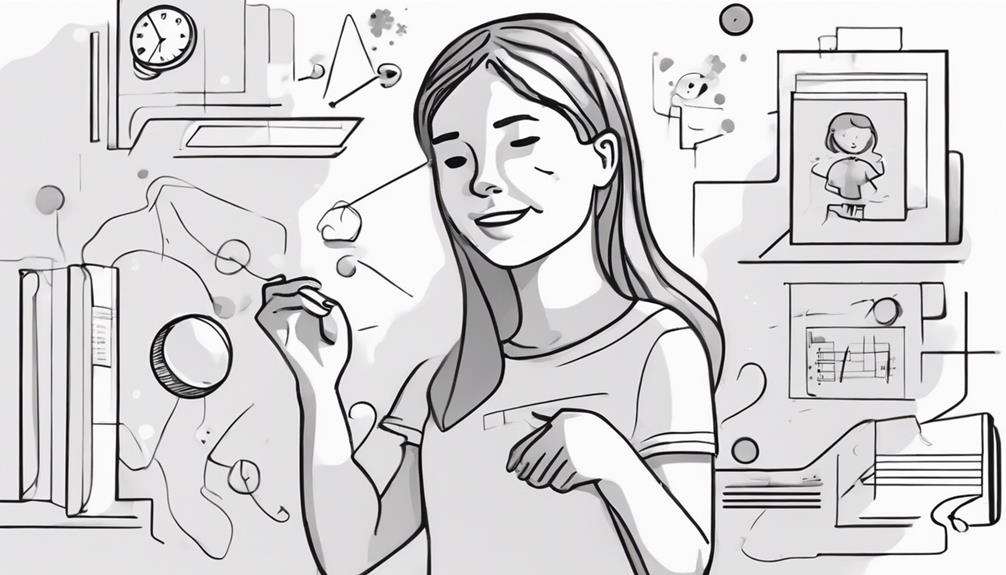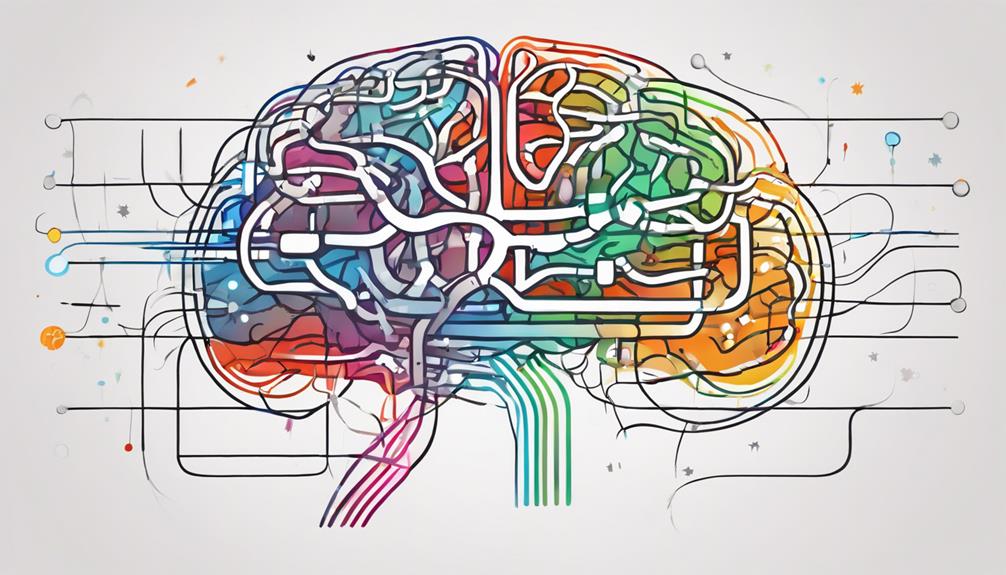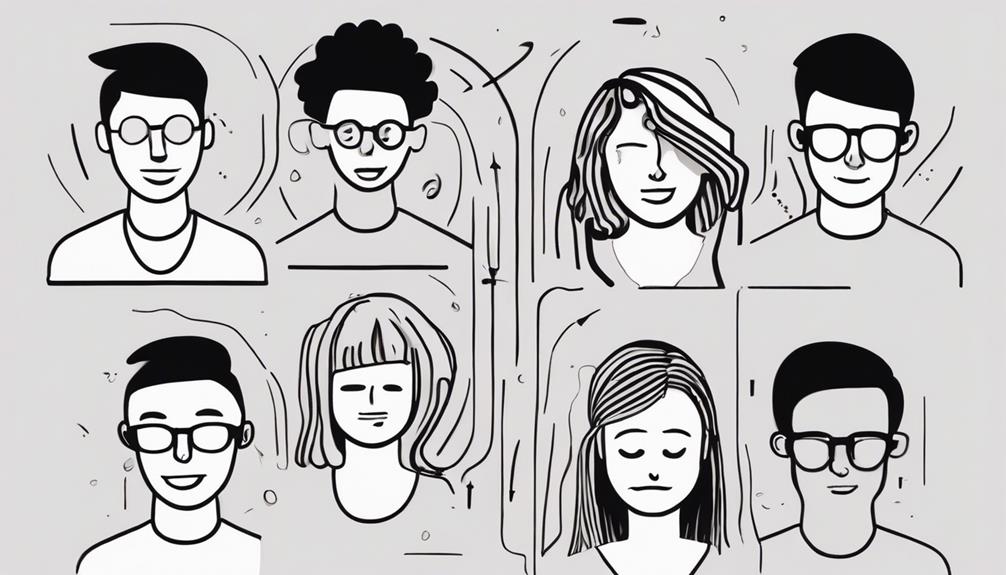Adolescence is a period marked by a myriad of changes, both physical and psychological, that contribute to the phenomenon of mood swings in teenagers. These fluctuations in emotional states are not merely random occurrences but rather a result of intricate processes happening within the teenage brain and body. Understanding the underlying mechanisms behind these mood swings is crucial for effectively supporting adolescents through this tumultuous phase of development. By unraveling the complexities of teenage mood swings, we can gain valuable insights into fostering their emotional well-being and promoting healthy coping mechanisms.
Key Takeaways
- Hormonal changes and neurotransmitter activity influence teenage mood swings.
- Identity development and external pressures contribute to emotional fluctuations.
- Artistic expression and social media impact how teenagers cope with mood swings.
- Peer influences, social media validation, and stress management strategies affect teenage mood swings.
Understanding Teenage Hormonal Changes

During adolescence, a pivotal period marked by profound physical and psychological transformations, understanding teenage hormonal changes is essential in deciphering the intricate mechanisms behind teenagers' fluctuating moods. Hormonal shifts, driven by increased production of sex hormones like estrogen and testosterone, significantly impact emotional responses in teenagers. These changes influence the delicate balance of neurotransmitters such as serotonin and dopamine, which play crucial roles in regulating mood and emotions in the adolescent brain.
The hypothalamus, pituitary gland, and gonads orchestrate the hormonal regulation process, affecting teenagers' emotional responses and mood variability. As teenagers undergo rapid physical changes, hormonal imbalances can lead to mood swings, irritability, and heightened emotional sensitivity. The interplay between hormonal changes and brain development elucidates why teenagers often experience pronounced mood fluctuations during this developmental stage. By comprehending the intricate relationship between adolescent brain maturation, hormonal shifts, and emotional responses, we can better grasp the complexities underlying teenagers' mood swings.
Impact of Identity Development
Identity development in adolescence is a multifaceted process that encompasses the exploration of values, beliefs, and personal characteristics. This period of self-discovery plays a crucial role in shaping an individual's sense of identity and self-concept. As teenagers grapple with questions about who they are and where they fit into the world, they may experience mood swings and emotional ups and downs. The quest to establish a unique identity can lead to heightened variability in mood as adolescents navigate the complexities of self-discovery.
During this phase, teens may encounter confusion and uncertainty as they try to understand and define themselves. This internal struggle to form a coherent and stable self-image contributes to the fluctuations in mood that are characteristic of adolescence. The process of identity exploration is closely intertwined with the experience of mood swings, as teens seek to reconcile their evolving sense of self with external expectations and social norms. By acknowledging the impact of identity development on emotional well-being, we can better understand the challenges that teenagers face during this transformative stage of life.
The Role of Self-Expression

Self-expression serves as a vital avenue for teenagers to navigate the complexities of their emotions during this developmental stage. Through artistic outlets, such as music, art, or writing, adolescents can externalize and process their feelings, contributing to fluctuations in mood. Additionally, the influence of social media and the quest for acceptance within peer groups further shape how teens express themselves and experience mood swings.
Artistic Outlets for Emotions
Engaging in artistic activities offers teenagers a valuable outlet to creatively express and process their intricate emotions. Artistic outlets, such as painting or music, serve as a therapeutic tool for adolescents to navigate the complexities of their feelings. Through self-expression in art, teenagers can release pent-up emotions in a healthy and constructive manner. This creative process not only allows them to explore their inner thoughts and emotions but also provides a non-verbal means of communication. By engaging in artistic expression, teenagers can reduce stress, improve their mood, and enhance their overall well-being. Artistic outlets offer a unique way for teenagers to cope with their fluctuating moods and develop a deeper understanding of themselves.
Influence of Social Media
The prevalence of social media platforms among teenagers has introduced a significant avenue for self-expression and emotional influence, shaping the way adolescents navigate their moods and self-perceptions. Teens often turn to social media as a means to express their thoughts, emotions, and experiences, which can impact their mood regulation. Seeking validation and feedback from peers on these platforms can influence teens' self-esteem and stability of mood. Additionally, comparison with others on social media may trigger feelings of inadequacy or low self-worth in teenagers. The constant connectivity and exposure to diverse content on these platforms can contribute to heightened emotional responses and mood fluctuations among teens. Understanding the role of social media in teenagers' emotional well-being is crucial for promoting healthy self-expression and mood management.
Peer Group Acceptance
Adolescents' pursuit of acceptance within their peer groups significantly influences the fluctuations in their emotional states as they navigate social interactions.
Key Points:
- Peer Group Acceptance: Seeking approval from peers can lead to mood swings in teenagers as they strive to fit in and be accepted within their social circles.
- Self-Expression: The need to express themselves authentically within their peer groups can impact teenagers' emotional responses and lead to mood changes.
- Emotional Responses: Adolescents may experience mood swings as they try to establish their identity and find their place among their peers.
Understanding the role of peer group acceptance and self-expression in teenagers' emotional responses provides insight into the complex dynamics that contribute to their mood fluctuations during this developmental stage.
Seeking Independence in Adolescence

During adolescence, teenagers often experience a strong desire for autonomy, leading to conflicts with parental authority. This struggle is rooted in the adolescent's need to push boundaries and establish independence. The quest for freedom and the ability to make personal choices can significantly influence the mood swings observed in teenagers during this developmental stage.
Teenage Desire for Autonomy
In the turbulent landscape of adolescence, teenagers embark on a relentless quest for autonomy, propelling them towards a tumultuous journey of self-discovery and defiance.
Key Points:
- Developmental Stage: Adolescents are at a crucial developmental stage where they strive to establish their independence and individuality.
- Challenges to Authority: Seeking autonomy often involves challenging existing rules and authority figures, leading to emotional fluctuations.
- Identity Formation: The process of autonomy-seeking is intertwined with the exploration of identity and self-expression, contributing to mood swings.
During this phase, teenagers' desire for autonomy can result in conflicts with parents and authority figures as they navigate the delicate balance between asserting control over their lives and the need for independence.
Struggles With Parental Authority
Struggles with parental authority commonly arise as teenagers in the phase of seeking independence navigate the delicate balance between asserting their autonomy and adhering to parental rules. The child's burgeoning need for self-expression and decision-making often conflicts with parental expectations, leading to mood swings and emotional upheavals in teens. This clash between the teen's quest for individuality and the parental structure can result in internal turmoil, causing fluctuations in mood. Adolescents strive to establish their identity while also pushing against the boundaries set by parents, which can trigger a range of emotions. Managing the desire for freedom with the need for guidance can be a significant source of mood swings in teenagers, highlighting the complexity of the parent-child dynamic during this developmental stage.
Pushing Boundaries for Freedom
The developmental phase of adolescence often prompts teenagers to challenge parental boundaries and assert their independence, leading to a natural inclination towards pushing against restrictions in their pursuit of freedom.
3 Reasons Why Teenagers Push Boundaries for Freedom:
- Identity Exploration: Adolescents seek to establish their own identities separate from their parents, driving them to test limits and assert independence.
- Desire for Autonomy: The teenage years mark a crucial period where autonomy becomes a primary goal, resulting in clashes with parental authority.
- Emotional Roller Coaster: The need for independence can trigger emotional reactions in teens, causing mood swings as they navigate the transition from childhood to adulthood.
These factors contribute to the emotional turbulence experienced by teenagers as they navigate the delicate balance between asserting their independence and respecting parental guidance.
Managing Teenage Stress Levels

Engaging in stress-reducing activities such as deep breathing exercises or mindfulness can be effective in managing teenage stress levels. Encouraging regular physical activity and promoting healthy eating habits are also crucial in regulating stress responses in teenagers. Establishing a consistent sleep schedule is essential to support proper rest and reduce stress-induced mood swings in teens. Open communication about stressors is key; providing a supportive environment for teenagers to express their feelings can significantly help in managing their stress levels.
To further assist teenagers in managing their stress, it is important to help them prioritize tasks, set realistic goals, and develop time management skills. This can alleviate stress and prevent mood swings by aiding in a more organized approach to daily challenges. Below is a table summarizing key strategies for managing teenage stress levels:
| Strategies | Description |
|---|---|
| Engage in stress-reducing activities | Practice deep breathing exercises or mindfulness techniques to reduce stress levels. |
| Encourage physical activity | Regular exercise helps regulate stress responses and promotes overall well-being in teenagers. |
| Establish consistent sleep schedule | Proper rest is crucial for stress management and can help reduce mood swings caused by lack of sleep. |
Influence of Teenage Social Life
The influence of teenage social life on mood swings is a complex interplay of various factors. Peer pressure and social media influence can significantly impact the emotional well-being of adolescents. Understanding how these elements shape social interactions is crucial in comprehending the fluctuations in teenagers' moods.
Peer Pressure Impact
Amidst the intricate web of teenage social life, the impact of peer pressure on mood swings stands as a pivotal factor shaping adolescents' emotional experiences.
Key Points:
- Social Influence: Peer pressure from social interactions can significantly influence teenagers' mood swings.
- Behavioral Conformity: Adolescents may feel pressured to conform to peers' behaviors, leading to emotional fluctuations.
- Comparison and Acceptance: Comparison with peers can trigger feelings of inadequacy or the need to fit in, affecting mood stability.
In the intricate dance of social dynamics, teenagers navigate the delicate balance of seeking acceptance within their social circles. The desire to belong and the fear of rejection can contribute to emotional fluctuations as teens grapple with the pressures of fitting in and standing out in their peer groups.
Social Media Influence
Comparison to idealized versions of others on social media can significantly influence teenagers' mood swings, adding a layer of complexity to their emotional experiences within their social circles. Teens today are constantly exposed to curated and filtered content on social media platforms, which can distort their perceptions of reality and lead to mood changes. Cyberbullying and negative comments online also play a role in triggering emotional distress among teenagers, affecting their overall mood. The pressure to maintain a certain image online further contributes to stress and anxiety in teens, impacting their emotional well-being. Here is a table summarizing the key aspects of how social media influences teenagers' mood swings:
| Aspects | Impact on Teens' Mood Swings |
|---|---|
| Idealized Comparisons | Negative |
| Cyberbullying | Emotional Distress |
| Image Maintenance | Stress and Anxiety |
Considering Neurodiversity Factors

In exploring the realm of teenagers' mood swings, a critical component to consider is the impact of neurodiversity factors on their emotional experiences.
Key Points to Consider:
- Brain Structure and Functioning: Neurodiversity factors encompass variations in brain structure and functioning, which can play a significant role in teens' moods and emotional regulation.
- Neurotransmitter Levels: Variations in neurotransmitter levels, such as dopamine, may influence how neurodiverse teenagers regulate their emotions, potentially leading to more pronounced mood swings.
- Sensitivity to Stimuli: Adolescents with neurodiverse conditions like ADHD or autism may exhibit heightened sensitivity to environmental stimuli, affecting how they experience and express emotions, thus contributing to fluctuations in their moods.
Understanding the interplay between neurodiversity factors and teenagers' mental health is crucial in comprehending the underlying mechanisms behind their mood swings. Recognizing these nuances can aid in developing tailored support strategies and interventions to assist teens in navigating their emotional experiences more effectively.
Parental Tips for Handling Mood Swings
To effectively support teenagers experiencing mood swings, parents can implement proactive strategies focused on maintaining a stable and nurturing environment at home. By staying calm and firm in their approach, parents can help manage mood swings in their teenagers. Encouraging healthy sleep habits and daily exercise can aid in regulating moods, while supporting a nutritious diet is crucial for emotional stability. It is essential for parents to monitor intense mood swings, signs of hopelessness, and changes in sleeping and eating patterns to identify and address mood swings promptly.
If concerning behaviors persist, parents should seek help from a mental health professional to ensure effective management of teenage mood swings. Prompt intervention is key in addressing mood swings before they escalate. By creating a supportive and understanding atmosphere at home, parents play a vital role in helping their teenagers navigate through these challenging emotional fluctuations.
Recognizing Duration of Mood Swings

Monitoring the frequency and intensity of mood swings in teenagers is crucial for discerning between typical emotional fluctuations and indicators of underlying issues. When it comes to recognizing the duration of mood swings, there are key points to consider:
- Variability: Mood swings in teenagers can vary in duration, from brief episodes to prolonged periods of instability. Understanding this variability is essential in distinguishing between normal teenage behavior and potential mental health concerns.
- Resolution Time: Normal teenage mood swings often resolve relatively quickly. However, persistent or severe mood changes that endure for extended periods may signal the need for further evaluation to ensure the teenager's mental health is adequately addressed.
- Professional Guidance: Seeking assistance from mental health professionals can provide valuable insights into the duration and impact of mood swings in teenagers. Professional guidance can help in determining whether the observed mood swings are within the typical range or require more comprehensive intervention to safeguard the teenager's mental well-being.
Identifying Severity and Warning Signs
Detecting the severity and recognizing warning signs associated with mood swings in teenagers is paramount for timely intervention and support. Prolonged periods of feeling down, irritability, or intense mood swings may indicate underlying mental health problems requiring attention. Persistent disruptions in daily routines and activities due to mood swings should be closely monitored as they can be signs of depression or other mood disorders. Changes in sleep patterns, appetite, and behavior can also serve as warning signs of more serious mood swing issues that may necessitate professional help. Seeking assistance from a mental health professional is crucial if mood swings significantly impact daily functioning. Addressing these warning signs promptly is essential to ensure that teenagers receive the necessary support and intervention to manage their mood swings effectively and prevent further deterioration in their mental well-being.
Impact on Different Life Domains

Mood swings in teenagers can significantly impact various aspects of their lives, including academic performance, social relationships, and family dynamics.
Impact on Different Life Domains:
- Academic Performance: Teenagers facing mood swings may find it challenging to concentrate on their studies due to emotional disturbances. This can result in decreased productivity, poor grades, and difficulty in retaining information. The fluctuating moods may also affect their motivation levels, leading to a lack of interest in academic activities.
- Social Relationships: The emotional instability associated with mood swings can strain friendships and peer interactions. Teenagers may exhibit unpredictable behaviors, causing misunderstandings and conflicts within their social circles. This could lead to feelings of isolation, alienation, and a sense of being misunderstood by their peers.
- Family Dynamics: Mood swings can disrupt the harmony within the family unit. Teenagers experiencing frequent emotional fluctuations may engage in arguments, defiance, or withdrawal from family members. This can create tension at home, impacting communication and trust among family members.
Knowing When to Seek Professional Help
The impact of persistent mood swings on teenagers' academic performance, social relationships, and family dynamics underscores the critical importance of recognizing when professional help may be necessary. Adolescents experiencing significant mood disturbances, especially those indicative of teen depression, should prompt immediate consideration of seeking professional assistance. Child and Adolescent psychiatrists, psychologists, or counselors specializing in teen mental health can provide valuable support and guidance in navigating these complex emotional challenges.
Recognizing the signs that a teenager's mood swings are more than just typical hormonal fluctuations is crucial. If mood swings are persistent, severe, or interfere with daily functioning, involving a professional becomes essential. Teenagers demonstrating symptoms of depression, such as prolonged sadness, loss of interest in activities, changes in appetite or sleep patterns, or thoughts of self-harm, should be evaluated by a qualified mental health professional promptly.
Frequently Asked Questions
Why Do Adolescents Get Mood Swings?
Adolescents experience mood swings due to a complex interplay of hormonal changes, stress, peer pressure, social media influence, lack of coping skills, and academic pressure. These factors contribute to emotional fluctuations in teenagers. The surge in hormones during puberty can lead to heightened emotional responses, while stressors from various sources exacerbate mood instability. Developing effective coping mechanisms and support systems are crucial in helping adolescents navigate these challenging emotional transitions.
Why Do Mood Swings Happen?
Mood swings, a common occurrence in adolescence, stem from intricate interactions within the developing brain. Hormonal fluctuations during puberty can trigger emotional volatility. Social pressures and academic demands further contribute to these shifts. Coping mechanisms and robust support systems are crucial in helping teenagers navigate these turbulent emotions. Understanding the physiological and environmental factors at play is essential in assisting adolescents in managing their mood swings effectively.
Do Mood Swings Go Away After Puberty?
Mood swings typically decrease in intensity and frequency after puberty due to the stabilization of hormonal levels and improved emotional regulation resulting from brain development. Post-puberty, teens develop better coping mechanisms and increased maturity, aiding in managing emotions more effectively. While some may still experience occasional mood swings influenced by psychological factors and social pressures, they are generally milder and more manageable compared to pre-puberty.
Why Do Mood Swings During Adolescence Occur Primarily?
Mood swings during adolescence primarily occur due to a complex interplay of factors. Hormonal changes, particularly increased estrogen and testosterone levels, influence emotional reactivity. Peer pressure and social media exposure add stress, impacting mood regulation. Brain development imbalances between the limbic system and prefrontal cortex contribute to impulsivity. Sleep deprivation further exacerbates mood fluctuations in teenagers. Understanding these elements can shed light on the origins of adolescent mood swings.
Conclusion
In conclusion, it is imperative to acknowledge the intricate interplay of various factors contributing to the phenomenon of mood swings in teenagers. By understanding the complex dynamics of hormonal changes, identity formation, and stress management, one can better navigate the turbulent waters of adolescent emotional fluctuations. It is crucial to approach these challenges with sensitivity and awareness, recognizing the significance of seeking appropriate support and intervention when necessary.
